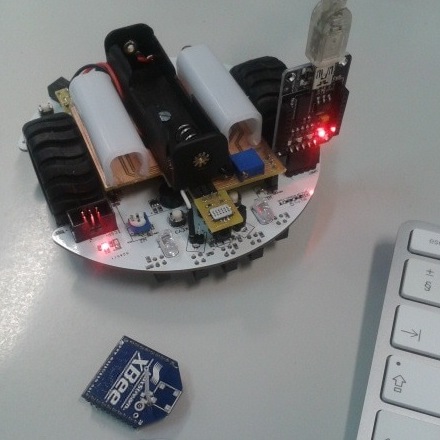| |
Load settings to the LSE miniQ EEPROM
Description: This tutorial will guide you through the process of loading settings on to the LSE miniQ EEPROM. This is particularly important if you are loading the default settings for the first time after programming a robot.Keywords: miniQ, settings
Tutorial Level: BEGINNER
Next Tutorial: Calibrate the PID velocity controllers Test your LSE miniQ
Overview
For this tutorial you'll need the following items:
- LSE miniQ robot (without XBee module)
- miniQ USB adapter connected to a computer running ROS

The setup_miniq node
The setup_miniq node was developed to download all the settings to a LSE miniQ. This should be done using a launch file containing all the settings for a LSE miniQ robot. Each robot should have its launch file, and these should be stored for future reference or if a robot needs its settings restored.
Default settings
The following example shows how to load the default settings on to a LSE miniQ. All you have to do is choose the ID you want to assign to your miniQ, in this example the ID is 5. Start by running a roscore.
rosrun lse_miniq_driver miniq_setup 5
Launch file settings
You can also save your settings in a launch file as mentioned previously and load them to your LSE miniQ whenever needed. For example:
roslaunch lse_miniq_driver setup_miniq_5.launch
The launch file contains all the settings:
<launch>
<node name="setup_miniq" pkg="lse_miniq_driver" type="setup_miniq" output="screen">
<param name="port" value="/dev/ttyUSB0" />
<param name="baudrate" value="57600" />
<param name="mode" value="0" />
<param name="starting_l_kp" value="250" />
<param name="starting_l_ki" value="0" />
<param name="starting_l_kd" value="0" />
<param name="running_l_kp" value="140" />
<param name="running_l_ki" value="25" />
<param name="running_l_kd" value="10" />
<param name="starting_r_kp" value="250" />
<param name="starting_r_ki" value="0" />
<param name="starting_r_kd" value="0" />
<param name="running_r_kp" value="140" />
<param name="running_r_ki" value="25" />
<param name="running_r_kd" value="10" />
<param name="battery_type" value="0" />
<param name="odometry_d" type="double" value="0.0" />
<param name="odometry_yaw" type="double" value="0.0" />
<param name="gas_a" type="double" value="0.0" />
<param name="gas_b" type="double" value="0.0" />
<param name="timeout" type="double" value="1.0" />
</node>
</launch>To learn more about each setting check the setup_miniq section on the lse_miniq_driver wiki page.
And that's it! Your LSE miniQ is now ready to roll! You can go ahead and test your LSE miniQ or you can calibrate the PID velocity controllers.







